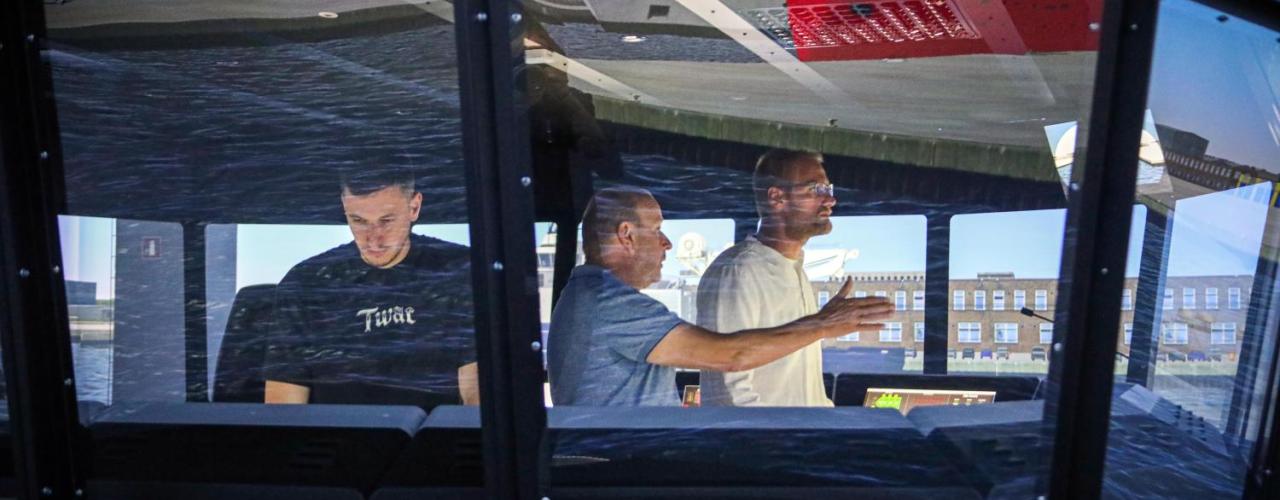
From sailor to captain to instructor
After 29 years working on seven different Jan De Nul vessels, Christof Osstijn was ready for a new challenge. Right then, he got the chance to become an instructor and supervise the delivery of the new Full Mission Simulator in Zeebrugge, a stone's throw from his home. From weeks at sea to daily cycling to work: there could not be a greater contrast in his working life. But just that was what Christof was looking for.
‘I am happy to pass on my years of experience on board to my colleagues. Even though I am the one teaching, I too am still learning every day and that is the best thing about my job,' Christof smiles.
The simulators in Focus
In Zeebrugge, we have three simulators in cooperation with VDAB and DEME. We use them to provide training for new colleagues, but deploy them equally well for crew who have been working on board for some time and want to acquire knowledge about new techniques. All three simulators have their own expertise, and each is impressive in its own way:
1. Loki – DP Simulator
Here, trainees perform a task in which the vessel controls its position and course with the dynamic positioning system. This is mainly where officers of the Offshore Fleet receive training. But Operational Superintendents and staff also follow inductions here.
2. Erism – Engine Simulator
This simulator mimics the engine room, the nerve centre, of the vessel. This is where all critical systems are monitored and controlled. Engineers from across the fleet receive training here.
3. Odin – Full Mission Simulator
This navigation simulator is the largest of the three and gives a unique (working) experience for officers. Anyone standing in this simulator imagines themselves on the bridge of one of our vessels.


This is the world's first navigation and dredging simulator, what exactly does that mean?
Christof: This simulator allows us to recreate life-like situations on board. For example, we can set up eight different vessel models, from split barge to cutter, during training. Each with its specific propulsion pre-programmed in the simulator. But we can also simulate projects from all over the world. Every officer receives basic training here, but we also play them a whole series of situations or incidents according to their experience, to which they then have to react appropriately.
Ideal for our new officers. Because when they start with us, they start working on board almost immediately. Not as a fully operational officer, but they do walk alongside our experienced colleagues. Although they already have many skills thanks to their studies, most of them have never sailed a dredger before. In time, they then come to this simulator where we teach them extra knowledge of manoeuvring and dredging, first in simple situations and gradually in increasingly complex situations.
On this simulator, they thus learn to navigate a vessel that is effectively dredging. Unique because this is the first simulator in the world to simulate the entire operating environment on the bridge, including dredging.
What do officers learn here in the simulator?
Christof: Usually, Officers come here for a week's training. I provide some theory, but as I said, the emphasis is primarily on learning how to manoeuvre. But they also learn dredging, rainbowing and wall presses, as well as how to couple to a floating line.
You can also learn to sail with the two different propulsion systems here: Shottle propulsion or conventional propulsion. These are two completely different ways of sailing. In that case, it is nice if you can practise here for a week before you switch types of propulsion systems.
Less obvious but equally important is communication on board. Here, we train hard on clear communication between team members during operations. On board, you have to be able to function as a group.

What ensures the lifelike (working) experience in this simulator?
Christof: First, we cooperate with the renowned Kongsberg for the realisation of this simulator. It takes 40 computers to run the system and 14 projectors provide the immersive experience in the simulator. Based on Google Earth data, S63 sea charts and our own survey, a lifelike environment is simulated.
On top of that, we can fully personalise the exercises. We can choose from three different types of Jan De Nul vessels for the execution: a cutter suction dredger, a trailing suction hopper or a split hopper barge. But we can also influence environmental factors such as location, time of day and weather conditions.
This true-to-life experience also makes this simulator an invaluable engineering tool during the preparation phase of a project. For example, we can fully simulate a project here and therefore prepare it down to the smallest details and advise our customers on their plans for the future. We did this recently for Oosterweel and the Al Omairah project. The customer of the latter followed the simulation remotely.
For you, when is a training successful?
Christof: I am a happy instructor when my trainees go home at the end of the week with new knowledge and experiences. The best thing about my job is that not only my trainees learn, but I too become a little bit wiser every day.